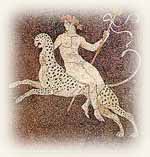The Grapevine Art & Soul Salon
Views and Reviews

The Magic of Cavalia by Charles Knott
I saw Cavalia twice. I wanted to understand the mystery and magic of the show. I believe I understand it.
The thing that makes it work is honoring the animals. There are no spectacularly trained or spectacularly talented animals in the show. Yet, the horses are glorious. How is this possible?
At the end of the show, while we were waiting to be escorted backstage to the stables to see the horses up close, a trainer came out on horseback and demonstrated a training session. What he did was gently put the horse through a dozen or so movements—figure eights, backwards prancing, starting and stopping—mainly, it seemed to me, just to enjoy the playfulness of command and response; all of this was simply again and again to strengthen the bond and the familiarity, again and again to rehearse the horse/rider habit of being together, working together, and understanding one another.
I have seen highly trained animals before, but Cavalia is different from, for example, the conventional circus. I once saw a circus act in which a cowboy and his pony did a comic routine which involved hundreds of scripted movements, even showing cowboy and pony getting drunk from the same bottle, then staggering around, playing tricks on each other, and finally passing out together on the ground.
In Cavalia, there are no Ph.D. psychologists working out behavioral agendas based on operant conditioning; rather, this training releases, rehearses and celebrates the intuitive understanding and natural friendship between human and animal. And, when the horses take the stage en masse, they are a community. Now that I think of it, they are almost like a little league baseball team—that is, children who know each other and have learned, nominally, to cooperate and work together. There is a childlikeness that makes their every achievement bring a moment of tearful pride to the eye of the beholder. And if—as happened in a magnificent performance by ten white stallions of a formal dance—one of the horses bites another in the ass while the trainer is not looking—well, so much the better!
About 20 years ago my father boarded a valuable young Arabian stallion in our back pasture. I used to walk out into the pasture to play with him. It was like playing with an infant. I would touch his neck, and he would rub his neck against my hand. I would step back, and he would step forward. I would move my feet this way and that in a kind of dance, and he would move his. I would stroke his muzzle, and he would put his face over my shoulder and rub my back with his chin. This playfulness would go on for as long as I would stay with him. There was nothing clingy: he was always glad to see me approach and content to see me leave. He was the perfect animal companion. Had I been a trainer, any training we would have done would have been an elaboration of the playful friendship.
Recently I have been trying to train our young Rottweiler not to leave the yard when I let her out the front door. But she would get excited when she picked up the scent of a deer that had wandered through our yard and beyond, and she would take off in pursuit, absolutely deaf to my voice calling her back. There seemed to be no way I could get her attention at such times. Then I found the solution. I took a 20-foot rope and tied it to her collar and walked her around the yard, giving her 20 feet of freedom and no more. I would call her and give a gentle tug on the rope so that the tug of the rope and the sound of my voice became synonymous. Then, when she was used to the feel of the rope, I would drop it and let her move around the yard merely feeling the rope dangling from her collar. She would rarely go more than 20 feet away from me, and she would turn and come to me when I called her. Now we walk in the yard without the rope, and she honors the 20-foot limit. All she needed was a demonstration and rehearsal; her natural instinct to please did the rest.
I am noticing a wide-scale renewed interest in animals these days, and animal owners are quite passionate about animal friendships. There is the old saying that if you want a friend, get yourself a dog, the ironic implication being that dogs make better friends than people. I’m not sure about that, but I know horses and dogs, at least, are forces for good when we don’t abuse or corrupt them. I am also sure that horses and dogs can make us better people when we listen to them, give them a chance, and accept the friendship they so generously offer.
Cavalia shows us how to make the most of this friendship. While I was watching these performances, I had the wonderful feeling of not wanting to be anywhere else but there in the eternally present moment—the moment I always am forgetting, the moment that the animals understand so well. They are always ready to take us there and help us find whatever sanity is ours to claim. I wouldn’t want to live without them.